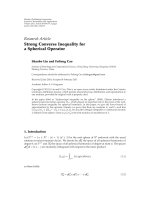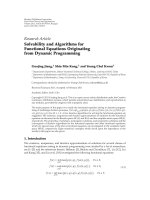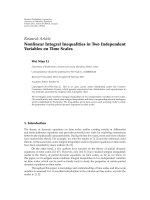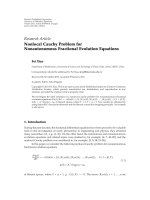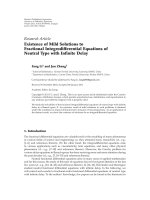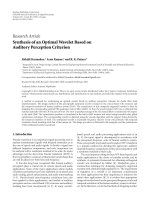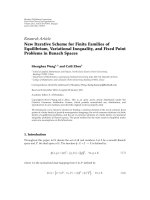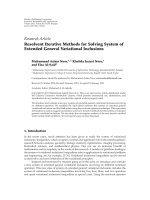Báo cáo hóa học: " Research Article Nonlocal Cauchy Problem for Nonautonomous Fractional Evolution Equations Fei Xiao" potx
Bạn đang xem bản rút gọn của tài liệu. Xem và tải ngay bản đầy đủ của tài liệu tại đây (539.52 KB, 17 trang )
Hindawi Publishing Corporation
Advances in Difference Equations
Volume 2011, Article ID 483816, 17 pages
doi:10.1155/2011/483816
Research Article
Nonlocal Cauchy Problem for
Nonautonomous Fractional Evolution Equations
Fei Xiao
Department of Mathematics, University of Science and Technology of China, Hefei, Anhui 230026, China
Correspondence should be addressed to Fei Xiao,
Received 28 November 2010; Accepted 29 January 2011
Academic Editor: Toka Diagana
Copyright q 2011 Fei Xiao. This is an open access article distributed under the Creative Commons
Attribution License, which permits unrestricted use, distribution, and reproduction in any
medium, provided the original work is properly cited.
We investigate the mild solutions of a nonlocal Cauchy problem for nonautonomous fractional
evolution equations d
q
ut/dt
q
−Atutft, K
1
ut, K
2
ut, ,K
n
ut,t∈ I 0,T,
u0A
−1
0guu
0
, in Banach spaces, where T>0, 0 <q<1. New results are obtained by
using Sadovskii’s fixed point theorem and the Banach contraction mapping principle. An example
is also given.
1. Introduction
During the past decades, the fractional differential equations have been proved to be valuable
tools in the investigation of many phenomena in engineering and physics; they attracted
many researchers cf., e.g., 1–9. On the other hand, the autonomous and nonautonomous
evolution equations and related topics were studied in, for example, 6, 7, 10–20,andthe
nonlocal C auchy problem was considered in, for example, 2, 5, 18, 21–26.
In this paper, we consider the following nonlocal Cauchy problem for nonautonomous
fractional evolution equations
d
q
u
t
dt
q
−A
t
u
t
f
t,
K
1
u
t
,
K
2
u
t
, ,
K
n
u
t
,t∈ I
0,T
,
u
0
A
−1
0
g
u
u
0
,
1.1
in Banach spaces, where 0 <q<1, g : CI; X → X.ThetermsK
i
ut, i 1, ,n are
2AdvancesinDifference Equations
defined by
K
i
u
t
t
0
k
i
t, s
u
s
ds, 1.2
the positive functions k
i
t, s are continuous on D {t, s ∈ R
2
:0≤ s ≤ t ≤ T} and
K
∗
i
sup
t∈0,T
t
0
k
i
t, s
ds < ∞. 1.3
Let us assume that u ∈ L0,T; X and At is a family linear closed operator defined
in a Banach space X. The fractional order integral of the function u is understood here in the
Riemann-Liouville sense, that is,
I
q
u
t
1
Γ
q
t
0
t − s
q−1
u
s
ds. 1.4
In this paper, we denote that C is a positive constant and assume that a family of closed
linear {At : t ∈ 0,T} satisfying
A1 the domain DA of {At : t ∈ 0 ,T} is dense in the Banach space X and in-
dependent of t,
A2 the operator Atλ
−1
exists in LX for any λ with Re λ ≤ 0and
A
t
λ
−1
≤
C
|
λ 1
|
,t∈
0,T
. 1.5
A3 There exists constant γ ∈ 0, 1 and C such that
A
t
1
− A
t
2
A
−1
s
≤ C
|
t
1
− t
2
|
γ
,t
1
,t
2
,s∈
0,T
. 1.6
Under condition A2,eachoperator−As, s ∈ 0,T generates an analytic semigroup
exp−tAs, t>0, and there exists a constant C such that
A
n
s
exp
−tA
s
≤
C
t
n
, 1.7
where n 0, 1, t>0, s ∈ 0,T11.
We study the existence of mild solution of 1.1 and obtain the existence theorem
based on the measures of noncompactness. An example is given to show an application of
the abstract results.
Advances in Difference Equations 3
2. Preliminaries
Throughout this work, we set I 0,T.WedenotebyX a Banach space, LX the space
of all linear and bounded operators on X,andCI, X the space of all X-valued continuous
functions on I.
Lemma 2.1 see 9. 1 I
q
: L
1
0,T → L
1
0,T.
2 For g ∈ L
1
0,T,wehave
t
0
η
0
t − η
q−1
η − s
γ−1
g
s
ds dη B
q, γ
t
0
t − s
qγ−1
g
s
ds, 2.1
where Bq, γ is a Beta function.
Definition 2.2. Let B be a bounded set of seminormed linear space Y. The Kuratowski’s
measure of noncompactness for brevity, α-measure of B is defined as
α
B
inf
d>0:B has a finite cover by sets of diameter ≤ d
. 2.2
From the definition, we can get some properties of α-measure immediately, see 27.
Lemma 2.3 see 27. Let A and B be bounded sets of X.Then
1 αA ≤ αB,ifA ⊆ B.
2 αAαA
cl
,whereA
cl
denotes the closure of A.
3 αA0 if and only if A is precompact.
4 αλA|λ|αA, λ ∈ R.
5 αA ∪ Bmax{αA,αB}.
6 αA B ≤ αAαB,whereA B {x y : x ∈ A, y ∈ B}.
7 αA x
0
αA, for any x
0
∈ X.
For H ⊂ CI, X we define
t
0
H
s
ds
t
0
u
s
ds : u ∈ H
, 2.3
for t ∈ I,whereHs{us ∈ X : u ∈ H}.
The following lemma will be needed.
Lemma 2.4 see 27. If H ⊂ CI,X is a bounded, equicontinuous set, then
1 αHsup
t∈I
αHt.
2 α
t
0
Hsds ≤
t
0
αHsds,fort ∈ I.
4AdvancesinDifference Equations
Lemma 2.5 see 28. If {u
n
}
∞
n1
⊂ L
1
I, X and there exists a m· ∈ L
1
I, R
such that
u
n
t
≤ m
t
, a.e t ∈ I, 2.4
then α{u
n
t}
∞
n1
is integrable and
α
t
0
u
n
s
ds
∞
n1
≤ 2
t
0
α
{
u
n
s
}
∞
n1
ds. 2.5
We need to use the following Sadovskii’s fixed point theorem.
Definition 2.6 see 29.LetP be an operator in Banach space X.IfP is continuous and takes
bounded, sets into bounded sets, and αPH <αH for every bounded set H of X with
αH > 0, then P is said to be a condensing operator on X.
Lemma 2.7 Sadovskii’s fixed point theorem 29. Let P be a condensing o perator on Banach
space X.IfP B ⊆ B for a convex, closed, and bounded set B of X,thenP has a fixed point in B.
According to 4, a mild solution of 1.1 can be defined as follows.
Definition 2.8. Afunctionu ∈ CI, X satisfying the equation
u
t
A
−1
0
g
u
u
0
t
0
ψ
t − η, η
U
η
A
0
A
−1
0
g
u
u
0
dη
t
0
ψ
t − η, η
f
η,
K
1
u
η
,
K
2
u
η
, ,
K
n
u
η
dη
t
0
η
0
ψ
t − η, η
ϕ
η, s
f
s,
K
1
u
s
,
K
2
u
s
, ,
K
n
u
s
ds dη,
2.6
is called a mild solution of 1.1,where
ψ
t, s
q
∞
0
θt
q−1
ξ
q
θ
exp
−t
q
θA
s
dθ, 2.7
and ξ
q
is a probability density function defined on 0, ∞ such that its Laplace transform is
given by
∞
0
e
−σx
ξ
q
σ
dσ
∞
j0
−x
j
Γ
1 qj
,q∈
0, 1
,x>0,
ϕ
t, τ
∞
k1
ϕ
k
t, τ
,
2.8
Advances in Difference Equations 5
where
ϕ
1
t, τ
A
t
− A
τ
ψ
t − τ, τ
,
ϕ
k1
t, τ
t
τ
ϕ
k
t, s
ϕ
1
s, τ
ds, k 1, 2 ,
U
t
−A
t
A
−1
0
−
t
0
ϕ
t, s
A
s
A
−1
0
ds.
2.9
To our purpose, the following conclusions will be needed. For the proofs refer to 4.
Lemma 2.9 see 4. The operator-valued functions ψt − η, η and Atψt − η, η are continuous
in uniform topology in the variables t, η,where0 ≤ η ≤ t − ε, 0 ≤ t ≤ T, for any ε>0. Clearly,
ψ
t − η, η
≤ C
t − η
q−1
. 2.10
Moreover, we have
ϕ
t, η
≤ C
t − η
γ−1
. 2.11
Remark 2.10. From the proof of Theorem 2.5 in 4,wecansee
1 Ut≤C Ct
γ
.
2 For t ∈ I,
t
0
ψt − η, ηUηdη is uniformly continuous in the norm of LX and
t
0
ψ
t − η, η
U
η
dη
≤ C
2
t
q
1
q
t
γ
B
q, γ 1
: M
t
. 2.12
3. Existence of Solution
Assume that
B1 f : I × X × X ×···×X → X satisfies f·,v
1
,v
2
, ,v
n
: I → X is measurable for all
v
i
∈ X, i 1, 2, ,n and ft, ·, ·, ,· : X × X ×···×X → X is continuous for
a.e t ∈ I, and there exist a positive function μ· ∈ L
p
I, R
p>1/q > 1 and a
continuous nondecreasing function ω : 0 , ∞ → 0, ∞ such that
f
t, v
1
,v
2
, ,v
n
≤ μ
t
ω
n
i1
v
i
,
t, v
1
,v
2
, ,v
n
∈ I × X × X ×···×X, 3.1
and set T
p,q
max{T
q−1/p
,T
q
}.
6AdvancesinDifference Equations
B2 For any bounded sets D, D
1
,D
2
, ,D
n
⊂ X,and0≤ τ ≤ s ≤ t ≤ T,
α
g
D
≤ β
t
α
D
,
α
ψ
t − s, s
f
s, D
1
,D
2
, ,D
n
≤ β
1
t, s
α
D
1
β
2
t, s
α
D
2
··· β
n
t, s
α
D
n
,
α
ψ
t − s, s
ϕ
s, τ
f
τ, D
1
,D
2
, ,D
n
≤ ζ
1
t, s, τ
α
D
1
ζ
2
t, s, τ
α
D
2
··· ζ
n
t, s, τ
α
D
n
,
3.2
where βt is a nonnegative function, and sup
t∈I
βt : β<∞,
sup
t∈I
t
0
β
i
t, s
ds : β
i
< ∞,i 1, 2, ,n,
sup
t∈I
t
0
s
0
ζ
j
t, s, τ
dτ ds : ζ
j
< ∞,j 1, 2, ,n.
3.3
B3 g : CI; X → X is continuous and there exists
0 <α
1
<
C M
T
−1
,α
2
≥ 0 3.4
such that
g
u
≤ α
1
u
α
2
. 3.5
B4 The functions μ and ω satisfy the following c ondition:
C
1 CB
q, γ
T
γ
p,q
Ω
p,q
n
i1
K
∗
i
μ
L
p
lim inf
τ →∞
ω
τ
τ
< 1 − α
1
C
M
T
, 3.6
where Ω
p,q
p − 1/pq − 1
p−1/p
,andT
γ
p,q
max{T
p,q
,T
p,qγ
}.
Theorem 3.1. Suppose that (B1)–(B4) are satisfied, and if C
MTβ 4Σ
n
i1
β
i
2ζ
i
K
∗
i
< 1,
then 1.1 has a mild solution on 0,T.
Advances in Difference Equations 7
Proof. Define the operator F : CI; X → CI; X by
F
u
t
A
−1
0
g
u
u
0
t
0
ψ
t − η, η
U
η
A
0
A
−1
0
g
u
u
0
dη
t
0
ψ
t − η, η
f
η,
K
1
u
η
,
K
2
u
η
, ,
K
n
u
η
dη
t
0
η
0
ψ
t − η, η
ϕ
η, s
f
s,
K
1
u
s
,
K
2
u
s
, ,
K
n
u
s
ds dη, t ∈ I.
3.7
Then we proceed in five steps.
Step 1. We show that F is continuous.
Let u
i
be a sequence that u
i
→ u as i →∞.Sincef satisfies B1,wehave
f
t,
K
1
u
i
t
,
K
2
u
i
t
, ,
K
n
u
i
t
−→ f
t,
K
1
u
t
,
K
2
u
t
, ,
K
n
u
t
, as i −→ ∞ .
3.8
Then
F
u
i
t
− F
u
t
≤
A
−1
0
g
u
i
− g
u
t
0
ψ
t − η, η
U
η
g
u
i
− g
u
dη
t
0
ψ
t − η, η
f
η,
K
1
u
i
η
,
K
2
u
i
η
, ,
K
n
u
i
η
−f
η,
K
1
u
η
,
K
2
u
η
, ,
K
n
u
η
dη
t
0
η
0
ψ
t − η, η
ϕ
η, s
f
s,
K
1
u
i
s
,
K
2
u
i
s
, ,
K
n
u
i
s
−f
s,
K
1
u
s
,
K
2
u
s
, ,
K
n
u
s
ds dη.
3.9
According to the condition A2, 2.12, and the continuity of g,wehave
A
−1
0
g
u
i
− g
u
−→ 0, as i −→ ∞ ;
t
0
ψ
t − η, η
U
η
g
u
i
− g
u
dη −→ 0, as i −→ ∞ .
3.10
8AdvancesinDifference Equations
Noting that u
i
→ u in CI,X,thereexistsε>0suchthatu
i
− u≤ε for i sufficiently large.
Therefore, we have
f
t,
K
1
u
i
t
,
K
2
u
i
t
, ,
K
n
u
i
t
− f
t,
K
1
u
t
,
K
2
u
t
, ,
K
n
u
t
≤ μ
t
⎡
⎣
ω
⎛
⎝
n
j1
K
j
u
i
t
⎞
⎠
ω
n
j1
K
j
u
t
⎤
⎦
≤ μ
t
⎡
⎣
ω
⎛
⎝
n
j1
K
∗
j
u
ε
⎞
⎠
ω
⎛
⎝
n
j1
K
∗
j
u
⎞
⎠
⎤
⎦
.
3.11
Using 2.10 and by means of the Lebesgue dominated convergence theorem, we obtain
t
0
ψ
t − η, η
f
η,
K
1
u
i
η
,
K
2
u
i
η
, ,
K
n
u
i
η
−f
η,
K
1
u
η
,
K
2
u
η
, ,
K
n
u
η
dη
≤ C
t
0
t − η
q−1
f
η,
K
1
u
i
η
,
K
2
u
i
η
, ,
K
n
u
i
η
−f
η,
K
1
u
η
,
K
2
u
η
, ,
K
n
u
η
dη,
−→ 0, as i −→ ∞ .
3.12
Similarly, by 2.10 and 2.11,wehave
t
0
η
0
ψ
t − η, η
ϕ
η, s
×
f
s,
K
1
u
i
t
,
K
2
u
i
t
, ,
K
n
u
i
t
−f
s,
K
1
u
s
,
K
2
u
s
, ,
K
n
u
s
ds dη
≤ C
2
t
0
η
0
t − η
q−1
η − s
γ−1
×
f
s,
K
1
u
i
t
,
K
2
u
i
t
, ,
K
n
u
i
t
−f
s,
K
1
u
s
,
K
2
u
s
, ,
K
n
u
s
ds dη
−→ 0, as i −→ ∞ .
3.13
Therefore, we deduce that
lim
i →∞
F
u
i
− F
u
0. 3.14
Advances in Difference Equations 9
Step 2. We show that F maps bounded sets of CI, X into bounded sets in CI, X.
For any r>0, we set B
r
{u ∈ CI, X : u≤r}. Now, for u ∈ B
r
,byB1,wecansee
f
t,
K
1
u
t
,
K
2
u
t
, ,
K
n
u
t
≤ μ
t
ω
⎛
⎝
n
j1
K
∗
j
r
⎞
⎠
. 3.15
Based on 2.12,wedenotethatSt :
t
0
ψt − η, ηUηdη,wehave
S
t
A
0
u
0
≤ C
2
t
q
1
q
t
γ
B
q, γ 1
A
0
u
0
M
t
A
0
u
0
. 3.16
Then for any u ∈ B
r
,byA2, 2.10, 2.11,andLemma 2.1,wehave
Fu
t
≤
A
−1
0
g
u
u
0
S
t
g
u
S
t
A
0
u
0
t
0
ψ
t − η, η
f
η,
K
1
u
η
,
K
2
u
η
, ,
K
n
u
η
dη
t
0
η
0
ψ
t − η, η
ϕ
η, s
f
s,
K
1
u
s
,
K
2
u
s
, ,
K
n
u
s
ds dη
≤
C
Mt
g
u
u
0
Mt
A
0
u
0
C
t
0
t − η
q−1
μ
η
ω
⎛
⎝
n
j1
K
∗
j
r
⎞
⎠
dη
C
2
t
0
η
0
t − η
q−1
η − s
γ−1
μ
s
ω
⎛
⎝
n
j1
K
∗
j
r
⎞
⎠
ds dη
≤ α
1
C
Mt
u
α
2
C
M
t
u
0
Mt
A
0
u
0
M
1
C
t
0
t − η
q−1
μ
η
dη C
2
B
q, γ
t
0
t − η
qγ−1
μ
η
dη
,
3.17
where M
1
ω
n
j1
K
∗
j
r.
By means of the H
¨
older inequality, we have
t
0
t − η
q−1
μ
η
dη t
pq−1/p
M
p,q
μ
L
p
≤ T
p,q
Ω
p,q
μ
L
p
,
t
0
t − η
γq−1
μ
η
dη ≤ T
p,qγ
Ω
p,qγ
μ
L
p
.
3.18
10 Advances in Difference Equations
Thus
Fu
t
≤ α
1
C
M
T
r α
2
C
M
T
u
0
M
T
A
0
u
0
M
1
Ω
p,q
T
γ
p,q
C C
2
B
q, γ
μ
L
p
: r.
3.19
This means FB
r
⊂ B
r
.
Step 3. We show that there exists m ∈ N such that FB
m
⊂ B
m
.
Suppose the contrary, that for every m ∈ N,thereexistsu
m
∈ B
m
and t
m
∈ I,suchthat
Fu
m
t
m
>m. However, on the other hand
f
t,
K
1
u
m
t
,
K
2
u
m
t
, ,
K
n
u
m
t
≤ μ
t
ω
⎛
⎝
n
j1
K
∗
j
m
⎞
⎠
, 3.20
we have
m<
Fu
m
t
m
≤ α
1
C
M
T
u
m
α
2
C
M
T
u
0
M
T
A
0
u
0
M
1
C
t
m
0
t
m
− η
q−1
μ
η
dη C
2
B
q, γ
t
m
0
t
m
− η
qγ−1
μ
η
dη
≤ α
1
C
M
T
u
m
α
2
C
M
T
u
0
M
T
A
0
u
0
M
1
Ω
p,q
T
γ
p,q
C C
2
B
q, γ
μ
L
p
≤ α
1
C
M
T
m α
2
C
M
T
u
0
M
T
A
0
u
0
M
1
Ω
p,q
T
γ
p,q
C C
2
B
q, γ
μ
L
p
.
3.21
Dividing both sides by m and taking the lower limit as m →∞,weobtain
C
1 CB
q, γ
T
γ
p,q
Ω
p,q
n
j1
K
∗
j
μ
L
p
lim inf
m →∞
w
m
m
≥ 1 − α
1
C
M
T
3.22
which contradicts B4.
Step 4. Denote
F
u
t
A
−1
0
g
u
u
0
t
0
ψ
t − η, η
U
η
A
0
A
−1
0
g
u
u
0
dη G
u
t
, 3.23
Advances in Difference Equations 11
where
G
u
t
t
0
ψ
t − η, η
f
η,
K
1
u
η
,
K
2
u
η
, ,
K
n
u
η
dη
t
0
η
0
ψ
t − η, η
ϕ
η, s
f
s,
K
1
u
s
,
K
2
u
s
, ,
K
n
u
s
ds dη.
3.24
We show that Gu· is equicontinuous.
Let 0 <t
2
<t
1
<Tand u ∈ B
m
.Then
Gu
t
1
−
Gu
t
2
≤I
1
I
2
I
3
I
4
, 3.25
where
I
1
t
2
0
ψ
t
1
− η, η
− ψ
t
2
− η, η
f
η,
K
1
u
η
,
K
2
u
η
, ,
K
n
u
η
dη,
I
2
t
1
t
2
ψ
t
1
− η, η
f
η,
K
1
u
η
,
K
2
u
η
, ,
K
n
u
η
dη,
I
3
t
2
0
η
0
ψ
t
1
− η, η
− ψ
t
2
− η, η
ϕ
η, s
f
s,
K
1
u
s
,
K
2
u
s
, ,
K
n
u
s
ds dη,
I
4
t
1
t
2
η
0
ψ
t
1
− η, η
ϕ
η, s
f
s,
K
1
u
s
,
K
2
u
s
, ,
K
n
u
s
ds dη.
3.26
It follows from Lemma 2.9, B1,and3.20 that I
1
,I
3
→ 0, as t
2
→ t
1
.
For I
2
,from2.10, 3.20,andB1,wehave
I
2
t
1
t
2
ψ
t
1
− η, η
f
η,
K
1
u
η
,
K
2
u
η
, ,
K
n
u
η
dη
≤ CM
1
t
1
t
2
t
1
− η
q−1
μ
η
dη −→ 0, as t
2
−→ t
1
.
3.27
Similarly, by 2.10, 2.11, B1,andLemma 2.1,wehave
I
4
t
1
t
2
η
0
ψ
t
1
− η, η
ϕ
η, s
f
s,
K
1
u
s
,
K
2
u
s
, ,
K
n
u
s
ds dη
≤ C
2
M
1
t
1
t
2
t
1
− η
q−1
η
0
η − s
γ−1
μ
s
ds dη −→ 0, as t
2
−→ t
1
.
3.28
12 Advances in Difference Equations
Step 5. We show that αFH <αH for every bounded set H ⊂ B
m
.Foranyε>0, we can
take a sequence {h
v
}
∞
v1
⊂ H such that
α
H
≤ 2α
{
h
v
}
ε, 3.29
cf. 30. So it follows f rom Lemmas 2.3–2.5, 2.9, 2 in Remark 2.10,andB2 that
α
F
H
≤ Cα
g
H
M
T
α
g
H
2α
G
{
h
v
}
ε
≤ Cα
g
H
M
T
α
g
H
2sup
t∈I
α
t
0
ψ
t − η, η
f
η,
K
1
h
v
η
,
K
2
h
v
η
, ,
K
n
h
v
η
dη
t
0
η
0
ψ
t − η, η
ϕ
η, s
×f
s,
K
1
h
v
s
,
K
2
h
v
s
, ,
K
n
h
v
s
ds dη
ε
≤ Cβα
H
M
T
βα
H
4sup
t∈I
t
0
α
ψ
t − η, η
f
η,
K
1
h
v
η
,
K
2
h
v
η
, ,
K
n
h
v
η
dη
8sup
t∈I
t
0
η
0
α
ψ
t − η, η
ϕ
η, s
f
s,
K
1
h
v
s
,
K
2
h
v
s
, ,
K
n
h
v
s
ε ≤ Cβα
H
M
T
βα
H
4sup
t∈I
t
0
n
i1
β
i
t, η
K
∗
i
α
{
h
v
}
dη
8sup
t∈I
t
0
η
0
n
i1
ζ
i
t, η, s
K
∗
i
α
{
h
v
}
ds dη
ε
≤ Cβα
H
M
T
βα
H
4
n
i1
β
i
K
∗
i
8
n
i1
ζ
i
K
∗
i
α
{
h
v
}
ε
C
M
T
β 4
n
i1
β
i
2ζ
i
K
∗
i
α
H
ε.
3.30
Since ε is arbitrary, we can obtain
α
F
H
≤
C
M
T
β 4
Σ
n
i1
β
i
2ζ
i
K
∗
i
α
H
<α
H
. 3.31
Advances in Difference Equations 13
In summary, we have proven that F has a fixed point u ∈ B
m
.Consequently,1.1 has
at least one mild solution.
Our next result is based on the Banach’s fixed point theorem.
G1 There exists a positive function l· ∈ L
1
I, R
and a constant μ>0suchthat
g
u
− g
u
∗
≤ μ
u − u
∗
,
f
t, v
1
,v
2
, ,v
n
− f
t, w
1
,w
2
, ,w
n
≤ l
t
n
i1
v
i
− w
i
,
v
i
,w
i
∈ X
2
,i 1, 2, ,n.
3.32
G2 There exists a constant 0 <δ<1 such that the function Λ : I → R
defined by
Λ
t
μ
C
M
T
C
n
i1
K
∗
i
Γ
q
I
q
l
t
C
2
n
i1
K
∗
i
Γ
q
Γ
γ
I
qγ
l
t
≤ δ, t ∈ I.
3.33
Theorem 3.2. Assume that (G1), (G2) are satisfied, then 1.1 has a unique mild solution.
Proof. Let F be defined as in Theorem 3.1.Foranyu, u
∗
∈ CI,X,wehave
f
t,
K
1
u
t
,
K
2
u
t
, ,
K
n
u
t
− f
t,
K
1
u
∗
t
,
K
2
u
∗
t
, ,
K
n
u
∗
t
≤ l
t
n
i1
K
i
u
t
−
K
i
u
∗
t
≤ l
t
n
i1
K
∗
i
u − u
∗
.
3.34
Thus, from A2, 2.10, 2.11, Lemma 2.1,wehave
Fu
t
−
Fu
∗
t
≤ μC
u − u
∗
μ
t
0
ψ
t − η, η
U
η
u − u
∗
dη
t
0
ψ
t − η, η
f
η,
K
1
u
η
,
K
2
u
η
, ,
K
n
u
η
−f
η,
K
1
u
∗
η
,
K
2
u
∗
η
, ,
K
n
u
∗
η
dη
t
0
η
0
ψ
t − η, η
ϕ
η, s
f
s,
Ku
s
,
Hu
s
− f
s,
Ku
∗
s
,
Hu
∗
s
ds dη
14 Advances in Difference Equations
≤
u − u
∗
μ
C
M
T
C
n
i1
K
∗
i
t
0
t − η
q−1
l
η
dη
C
2
n
i1
K
∗
i
t
0
η
0
t − η
q−1
η − s
γ−1
l
s
ds dη
μ
C M
T
C
n
i1
K
∗
i
Γ
q
I
q
l
t
C
2
n
i1
K
∗
i
Γ
q
Γ
γ
I
qγ
l
t
u − u
∗
Λ
t
u − u
∗
.
3.35
We get
F
u
− F
u
∗
≤ δ
u − u
∗
. 3.36
By the Banach contraction mapping principle, F has a unique fixed point, which is a mild
solution of 1.1.
4. An Example
To illustrate the usefulness of our main result, we consider the following fractional differential
equation:
∂
q
∂t
q
u
t, ξ
b
t, ξ
∂
2
∂ξ
2
u
t, ξ
t
n
n
t
0
t − s
u
s, ξ
ds
t
n
n
t
0
e
−ts
u
s, ξ
ds, ξ ∈
0, 1
,
u
t, 0
u
t, 1
0,
u
0,ξ
−
ξ
0
y
0
b
−1
0,x
sin
u
λ
dx dy,
4.1
where 0 <q<1, 0 ≤ t ≤ 1, λ>C
M1, n ∈ N, bt, ξ is continuous function and is uniformly
H
¨
older continuous in t, that is, there exist C>0andγ ∈ 0, 1 such that
b
t
1
,ξ
− b
t
2
,ξ
≤ C
|
t
1
− t
2
|
γ
, 0 ≤ t
1
≤ t
2
≤ 1. 4.2
Let X L
2
0, 1,R and define At by
D
A
t
H
2
0, 1
∩ H
1
0
0, 1
H
2
0, 1
: z
0
z
1
0
,
−A
t
z
b
t, ξ
z
.
4.3
Then −As generates an analytic semigroup exp−tAs.
Advances in Difference Equations 15
For t ∈ 0, 1, ξ ∈ 0, 1,weset
u
t
ξ
u
t, ξ
,
g
u
sin
u
λ
,
A
−1
0
g
u
−
ξ
0
y
0
b
−1
0,x
sin
u
λ
dx dy,
f
t,
K
1
u
t
,
K
2
u
t
ξ
t
n
n
t
0
t − s
u
s, ξ
ds
t
n
n
t
0
e
−ts
u
s, ξ
ds,
4.4
where
K
1
u
t
ξ
t
0
t − s
u
s, ξ
ds,
K
2
u
t
ξ
t
0
e
−ts
u
s, ξ
ds,
K
∗
1
sup
t∈I
t
0
t − s
ds <
1
2
< ∞,
K
∗
2
sup
t∈I
t
0
e
−ts
ds
1
4
< ∞.
4.5
Moreover, we can get
g
u
≤
1
λ
u
,
α
g
D
≤
1
λ
α
D
4.6
for any D ⊂ X. Then the above equation 4.1 can be written in the abstract form as 1.1.On
the other hand,
f
t,
Ku
t
,
Hu
t
ξ
≤
t
n
n
K
1
u
t, ξ
K
2
u
t, ξ
≤
t
n
n
K
∗
1
u
K
∗
2
u
μ
t
ω
K
∗
1
u
K
∗
2
u
,
4.7
16 Advances in Difference Equations
where μtt
n
, ωzz/n satisfying B1.Foranyu
1
,u
2
∈ X,
ψ
t − s, s
f
s,
K
1
u
1
s
,
K
2
u
1
s
ξ
− ψ
t − s, s
f
s,
K
1
u
2
s
,
K
2
u
2
s
ξ
≤
Cs
n
n
t − s
q−1
K
1
u
1
s
ξ
−
K
1
u
2
s
ξ
K
2
u
1
s
ξ
−
K
2
u
2
s
ξ
.
4.8
Therefore, for a ny bounded sets D
1
,D
2
⊂ X,wehave
α
ψ
t − s, s
f
s, D
1
,D
2
≤
Cs
n
n
t − s
q−1
α
D
1
α
D
2
.
4.9
Moreover,
C
n
sup
t∈0,1
t
0
t − s
q−1
s
n
ds
C
n
sup
t∈0,1
t
nq
B
q, n 1
C
n
B
q, n 1
: β
1
β
2
. 4.10
Similarly, we obtain
α
ψ
t − s, s
ϕ
s, τ
f
τ, D
1
,D
2
≤
C
2
n
t − s
q−1
s − τ
γ−1
τ
n
α
D
1
α
D
2
,
C
2
n
sup
t∈0,1
t
0
s
0
t − s
q−1
s − τ
γ−1
τ
n
dτ ds ≤
C
2
n
B
q, γ
B
q γ,n 1
: ζ
1
ζ
2
.
4.11
Suppose further that
13/4nC1 CBq, γp − 1/pq − 1
p−1/p
μ
L
p
< 1 − C M1/λ,
21/λC
M1 3β
1
2ζ
1
< 1.
Then 4.1 has a mild solution by Theorem 3.1.
References
1 R. P. Agarwal, M. Belmekki, and M. Benchohra, “A survey on semilinear differential equations and
inclusions involving Riemann-Liouville fractional derivative,” Advances in Difference Equations,vol.
2009, Article ID 981728, 47 pages, 2009.
2 A. Anguraj, P. Karthikeyan, and G . M. N’Gu
´
er
´
ekata, “No nlocal Cauchy problem for some fractional
abstract integro-differential equations in Banach spaces,” Communications in Mathematical Analysis,
vol. 6, no. 1, pp. 31–35, 2009.
3 M. M. El-Borai, “Some probability densities and fundamental solutions of fractional evolution
equations,” Chaos, Solitons and Fractals, vol. 14, no. 3, pp. 433–440, 2002.
4 M. M. El-Borai, “The fundamental solutions for fractional evolution equations of parabolic type,”
Journal of Applied Mathematics and Stochastic Analysis, no. 3, pp. 197–211, 2004.
5 F. Li, “Mild solutions for fractional differential equations with nonlocal conditions,” Advances in
Difference Equations, vol. 2010, Article ID 287861, 9 pages, 2010.
6 F. Li, “Solvability of nonautonomous fractional integrodifferential equations with infinite delay,”
Advances in Difference Equations, vol. 2011, Article ID 806729, 18 pages, 2011.
Advances in Difference Equations 17
7 J. Liang and T J. Xiao, “Solutions t o nonautonomous abstract functional equations with infinite
delay,” Taiwanese Journal of Mathematics, vol. 10, no. 1, pp. 163–172, 2006.
8 G. M. Mophou, “Existence and uniqueness of mild solutions to impulsive fractional differential
equations,” Nonlinear Analysis: Theory, Methods & Applications, vol. 72, no. 3-4, pp. 1604–1615, 2010.
9 S. G. Samko, A. A. Kilbas, and O. I. Marichev, Fractional Integrals and Derivatives: Theory and
Applications, Gordon and Breach Science, New York, NY, USA, 1993.
10 T. Diagana, “Pseudo-almost automorphic solutions to some classes of nonautonomous partial
evolution equations,” Differential Equations & Applications, vol. 1, no. 4, pp. 561–582, 2009.
11 E. Hille and R. S. Phillips, Functional Analysis and Semi-Groups,vol.31ofAmerican Mathematical Society
Colloquium Publications, American Mathematical Society, Providence, RI, USA, 1957.
12 K. Josi
´
c and R. Rosenbaum, “Unstable solutions of nonautonomous linear differential equations,”
SIAM Review, vol. 50, no. 3, pp. 570–584, 2008.
13 M. Kunze, L. Lorenzi, and A . Lunardi, “Nonautonomous Kolmogorov parabolic equations with
unbounded coefficients,” Transactions of the American Mathematical Society, vol. 362, no. 1, pp. 169–198,
2010.
14 J. Liang, R. Nagel, and T J. Xiao, “Approximation theorems for the propagators of higher order
abstract Cauchy problems,” Transactions of the American Mathematical Society, vol. 360, no. 4, pp. 1723–
1739, 2008.
15 A. P azy, Semigroups of Linear Operators and Applications to Partial Differential Equations,vol.44ofApplied
Mathematical Sciences, Springer, New York, NY, USA, 1983.
16 T J. Xiao and J. Liang, The Cauchy Problem for Higher-Order Abstract D ifferential Equations, vol. 1701 of
Lecture Notes in Mathematics, Springer, Berlin, G ermany, 1998.
17 T J. Xiao and J. Liang, “Approximations o f Laplace transforms and integrated semigroups,” Journal
of Functional Analysis, vol. 172, no. 1, pp. 202–220, 2000.
18
T J. Xiao and J. Liang, “Existence of classical solutions to nonautonomous nonlocal parabolic
problems,” Nonlinear Analysis: Theory, Methods and Applications, vol. 63, no. 5–7, pp. e225–e232, 2005.
19 T J. Xiao and J. Liang, “Second order differential operators with Feller-Wentzell type boundary
conditions,” Journal of Functional Analysis, vol. 254, no. 6, pp. 1467–1486, 2008.
20 T J. Xiao, J. Liang, and J. van Casteren, “Time dependent Desch-Schappacher type perturbations of
Volterra integral equations,” Integral Equations and Operator Theory, vol. 44, no. 4, pp. 494–506, 2002.
21 L. Byszewski and V. Lakshmikantham, “Theorem about the existence and uniqueness of a solution of
a nonlocal abstract Cauchy problem in a Banach space,” Applicable Analysis, v ol. 40, no. 1, pp. 11–19,
1991.
22 Z. Fan, “Impulsive problems for semilinear differential equations with nonlocal conditions,”
Nonlinear Analysis: Theory, Methods & Applications, vol. 72, no. 2, pp. 1104–1109, 2010.
23 J. Liang and T J. Xiao, “Semilinear integrodifferential equations with nonlocal initial conditions,”
Computers & Mathematics with Applications, vol. 47, no. 6-7, pp. 863–875, 2004.
24 J. Liang, J. H. Liu , and T J. Xiao, “Nonlocal problems for integrodifferential equations,” Dynamics of
Continuous, Discrete & Impulsive Systems. Series A, vol. 15, no. 6, pp. 815–824, 2008.
25 J. Liang, J. van Casteren, and T J. Xiao, “Nonlocal Cauchy problems for semilinear evolution
equations,” Nonlinear Analysis: Theory, Methods & Applications, vol. 50, no. 2, pp. 173–189, 2002.
26 H. Liu and J C. Chang, “Existence for a class of partial differential equations with nonlocal
conditions,” Nonlinear Analysis: Theory, Methods & Applications, vol. 70, no. 9, pp. 3076–3083, 2009.
27 J. Bana
´
s and K. Goebel, Measures of Noncompactness in Banach Spaces,vol.60ofLecture Notes in Pure
andAppliedMathematics, Marcel Dekker, New York, NY, USA, 1980.
28 H P. Heinz, “On the behaviour of measures of noncompactness with respect to differentiation and
integration of vector-valued functions,” Nonlinear Analysis: Theory, Methods & Applications,vol.7,no.
12, pp. 1351–1371, 1983.
29 B. Sadovskii, “On a fixed point principle,” Functional Analysis and Its Applications, vol. 2, pp. 151–153,
1967.
30 D. Bothe, “Multivalued perturbations of m-accretive di
fferential inclusions,” Israel Journal of Mathe-
matics, vol. 108, pp. 109–138, 1998.
